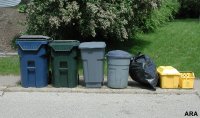 (ARA) – How can you make your community more responsible for reducing waste and preventing global climate change? How can you help residents save money at the same time?
(ARA) – How can you make your community more responsible for reducing waste and preventing global climate change? How can you help residents save money at the same time?
‘Pay-As-You-Throw’ (PAYT) is a trash collection rate-setting system that promotes economic savings and environmental benefits. Environmentally conscious communities have been using this holy grail of environmental solutions since the early 1900s, though it’s an approach few people know about.
According to a new national analysis sponsored by the U.S. Environmental Protection Agency (EPA) and Skumatz Economic Research Associates, Inc. (SERA), nearly 7,100 communities are successfully using PAYT in the United States, along with communities in more than 17 countries abroad.
Here’s how it works: Under traditional trash collection arrangements where residents pay for trash and sometimes recycling collection through a flat fee bill or the general tax base, residents incur no financial consequences no matter how much or little they throw away. With PAYT, municipalities charge residents for the number of bags they throw away or the size of the trash containers they use, similar to how we pay for electricity and gas. By attaching a unit price to the quantity residents throw away, PAYT provides a financial incentive for people throw out less, which means buying less and reusing, recycling, and composting more. In fact, studies show that cities reduce their waste by about 25 percent with PAYT.
Reducing the amount of waste generated also means fewer greenhouse gases are produced during a product’s life cycle. When residents recycle their waste rather than throw it away, their recycled materials are turned into new products, helping to limit the demand for virgin materials and saving the energy that would otherwise be required to harvest, process, and manufacture brand new products. Reducing energy use decreases the burning of fossil fuels, resulting in less greenhouse gas emissions (carbon dioxide, methane, and nitrous oxides) in the air. Likewise when residents buy less to begin with or reuse or donate things rather than simply throwing them away.
PAYT programs are now available in approximately 25 percent of communities in the United States, covering about 75 million residents. States with the largest share of communities with PAYT available include Minnesota, Washington, Oregon, Wisconsin, New Hampshire, Massachusetts, Iowa, California, Michigan, and New York, all with PAYT available in 40 percent or more of the communities in the state. In Minnesota alone, there are nearly 1,850 communities using PAYT.
In addition, current PAYT programs offer tangible greenhouse gas reductions, reducing between 2.1 million to 3.8 million metric tons of carbon equivalents annually. That’s equivalent to not driving 1.6 million to more than 3 million passenger cars for a year!
Reports and articles about PAYT have documented the following successes:
* Gainesville, Fla., saved $200,000 in landfill tipping fees after implementing PAYT, reduced solid waste collection by 18 percent, and increased its recycling rate by about 25 percent.
